Wild food author and expert Geoff Dann explores the overlooked edible seaweed as a delicious and nutritious addition to the wild food table and shares one of his seasonal recipes.
Non-animal wild food falls into three main categories: terrestrial plants, seaweeds and fungi. Of these, the only one we’ve truly embraced during the foraging renaissance of recent years is the first. Most people are happy with the idea of foraging for fruits and nuts (although you might be surprised how many people opened their windows and bemusedly asked “What are you doing?” on their way out of the car park of McDonalds on the junction of the A24 and A272 as me and my mate filled several carrier bags with apples for cider-making a few years back). Most professional foragers focus mainly on edible wild plants, most foraging books cover far more plants than anything else, and most foragers are most comfortable when foraging for plants. This is partly because we are surrounded by plants and that historically they have been far more important as human food than species in the other two categories, but that isn’t the only reason.

Oarweed (Laminaria digitata)(photo taken in June)
There is no mystery why a lot of people are reluctant to forage for wild fungi. They are well aware of the potentially fatal consequences of getting the identification wrong, and many fungi aren’t easily identified. I am hoping that my book Edible Mushrooms, is going to help make the learning process easier (it is by far the most comprehensive ever published on that topic, and aimed at everybody from beginners to experts). However, there is no getting away from the fact that learning fungi foraging cannot be rushed, however good your information source. The sheer number of fungi (over seven times as many species as plants), the relative difficulty in accurately identifying many of them, as well as their elusiveness, means you have no choice but to take your time. Better safe than sorry.
Once safely identified, though, the British are generally quite happy and adventurous when it comes to eating wild fungi…or perhaps I should say “wild mushrooms”. If it is mushroom-shaped and we can bung it in a frying pan with some garlic, then we can be pretty adventurous. We tend to be less so if, rather than being a mushroom, the fungus looks like a brain the size of a football or is a bracket or an ear-shaped jelly thing. Try putting some Jew’s Ears (no the name is not anti-semitic) into a frying pan and they’ll just explode all over your kitchen wall, and here is a clue to the problem with seaweeds: there are some types of food that are so alien to traditional European cookery that we don’t know where to start when presented with them. What you should do with Jew’s Ears? Well, isn’t the obvious thing to refer to oriental cuisine, where their close relatives are commonplace? Jew’s Ears work best in Hot and Sour Soup. It’s not hard to make – you just need the right ingredients and follow the recipe (hundreds of variations of which can be found online).

Jew’s Ears – tasty, when cooked right.
There is no problem with poisonous seaweeds in Europe. There is only one dangerously-poisonous European seaweed – a “suicide bomber” in the genus Desmarestia called “Acid Weed”, which releases sulphuric acid when damaged, destroying itself, its neighbours, and maybe whatever damaged it. Fortunately it doesn’t grow above the low tide line, so unless you are planning on diving for dinner, you’re pretty safe. You can get into trouble foraging in polluted water, which is very sad if not very surprising, but can be avoided with a bit of common sense.
No…the real problem with seaweeds is that the British have no idea what to do with them. I’m often asked “which are the best seaweeds just to use as a side vegetable?” The answer is probably Dulse, but the question betrays a lack of culinary curiosity and versatility. It is perhaps not surprising that Dulse is also probably the best known edible seaweed in Britain – after all, you can just chop it up and put it in mashed potato! Or make crisps out of it, or just nibble it raw. There’s so much more to edible seaweeds.

Pepper Dulse (Osmundia pinnatifida)
There is a British tradition of seaweed-eating – it comes from “the Celtic Fringe” and is a mixture of both alien and familiar. Take Laver for example. A lot of people have heard of “Laver Bread”, but even if they know that Laver is a type of seaweed, they tend to assume “Laver Bread” is a baked product flavoured with seaweed. In fact it is better described as a sort of “pudding”, made by simmering Laver for hours until it is reduced to a slushy gloop, and then rolling it in, or mixing it with, oats, and frying. Once tasted, most people will greedily come back for more – it is umami overload, as well as tasting healthy (and it is very nutritious). And yet while it is unfamiliar to most of us, it is a traditional part of a “Full Welsh Breakfast”, along with everything else that you’d expect to find in a Full British Breakfast, along with, erm, cockles.
But if you really want to go to town with Edible Seaweeds, then you need to look east. Seaweeds comprise over 10% of the national diet in Japan, and a similar amount in several other south-east Asian countries. And while many of the Asian species cannot be found in northern European waters, in most cases a closely-related substitute does occur, and often in far greater abundance than in Asia because here there is nobody picking it.

One seaweed most commonly known in British food – Laver
So where is the best source of information about edible seaweeds in the UK? There is no definitive guide. There are some decent online guides (including one very recently published by Robin Harford, which costs £15), and some good, if not entirely comprehensive, books. Prannie Rhatigan’s “Irish Seaweed Kitchen” is probably the best, although it is rather expensive and very much focused on the Celtic tradition. The seaweed section of Miles Irving’s “Forager Handbook” is also good (although the black and white photos are no use for ID purposes). John Wright’s River Cottage Coastal Handbook isn’t bad, although covers fewer species than the previous two.
The most comprehensive guide I am aware of is no longer in print, but second-hand copies can be found for a sensible price – “Seaweed: A User’s Guide” by Sonia Surey-Gent and Gordon Morris (although again, printed in black and white and absolutely useless for ID). I am working on a second book which will include the most comprehensive guide to edible British seaweeds, but that will not come out until late 2019 at the earliest.

Three Cornered Leek
In the meantime, below is my offering of an Asian-inspired recipe using British seaweeds in season right now (please credit me if you re-use it – it is my own invention, regardless of its strong Japanese and Thai influences.) Some species of edible seaweeds can be found from mid-winter, but it is in the spring and summer that the richest bounty is to be had. A lot of species haven’t got properly going yet, but it won’t be long before they do, and a couple of the best are already available. Oarweed is a type of Kelp that can be found on semi-exposed rocky coastlines at or near the lowest low tide line. It is highly nutritious (full of vitamins, minerals and other micro-nutrients).
Pepper Dulse can be found from considerably further up the beach down towards the low tide line, but can be somewhat harder to track down. It has a very strong flavour, so much so that its nutrient content is irrelevant, because you aren’t going to need much of it. The other wild ingredient in this recipe is an Allium that is easily found along the south-coast in in south-west England, less so elsewhere. If you can’t find it then you can use Ramsons (“Wild Garlic”) as a substitute, but it has a stronger flavour, so reduce the amount and include some other, less-pungent, salad leaf.
Recipe for King Prawn, Oarweed and Three-cornered Leek salad, with Pepper Dulse

King Prawn, Oarweed and Three-Cornered Leek salad, with Pepper Dulse
(Serves 4)
Salad:
150g fresh (or reconstituted) Oarweed or Cuvie (Tangle)
100g high-quality tomato, roughly chopped
100g cucumber, roughly chopped
50g three-cornered leek leaves, roughly chopped
30g coriander leaves (no large stalks), finely chopped
One large red chilli, deseeded and finely chopped
20 king prawns
Garnish:
A few sprigs of fresh Pepper Dulse
A few Three-Cornered Leek flowers (unopened buds are also good)
A sprinkling of sesame seeds (black is more authentic, but I didn’t have any to hand so I used normal ones this time)
Dressing:
Juice of one lime (5 tbsp)
5 tbsp fish sauce
1 tsp muscovado sugar
Method:
- Bring a pan of water to the boil and simmer the Kelp for 5-6 minutes, then douse in cold water and drain.
2. Put the kelp, tomato, cucumber, coriander, three-cornered leek leaves and chilli in to a bowl and mix well.
3. Prepare the dressing (add all the ingredients to a small bowl and mix).
4. Plate up the salad mix, with the prawns in the middle, then add 2 tbsps of dressing to each plate and garnish with Three-cornered Leek flowers and sesame seeds on top and Pepper Dulse at the side.

Geoff Dann
About the author
I am a fungi and foraging expert, teacher and writer based in Hastings. I spend my autumns accompanying small, self-assembled groups (families, groups of friends, couples) on walks in search of fungi, usually on public access land. I also collaborate with landowners to offer longer foraging courses for larger groups. In the evenings I give talks, and bring a selection of whatever is currently available for people to try. I also run coastal foraging sessions in the spring and summer, and I am available for foraging and fungi/plant ID sessions at all times of the year.
If you live in the south-east you’d like to come on a guided forage for these seaweeds yourself, and try a variation on this recipe, please see my website here.

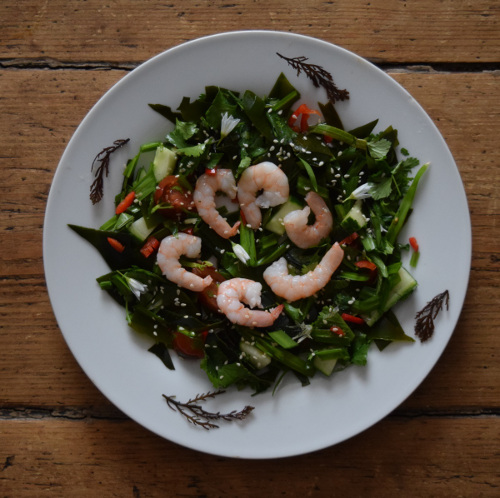

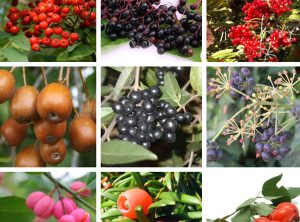
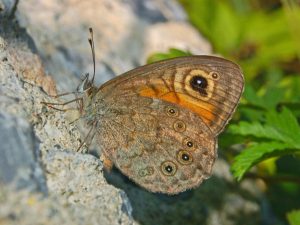
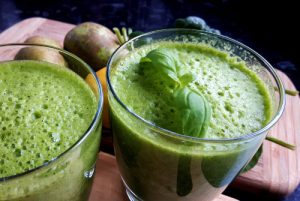

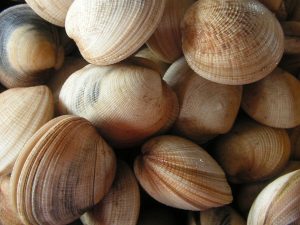
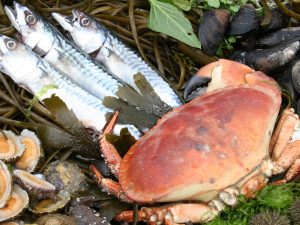
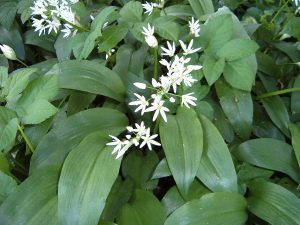
3 Comments
Lovely blog… however, I keep googling foraging for seaweed in the UK and time and time again, the issue of pollution is skirted over as if it’s ‘common sense’ to know how to avoid it. It isn’t. Most people don’t live near the sea for a start. Most people may have grown up in times of lower pollution in the sea compared to these days. And it’s very unhelpful and time wasting to devote so many blogs across the internet to the various safety of eating any variety available… and you all refer to the pollution issue and none of you so far have offered a shred of guidance as to how to safely eat or find or prepare non polluted seaweed, nor has anyone I could find so far, ventured to guide as to how you can tell it the seaweed is polluted, how deadly the pollution issue is (ie. Many crops have pesticides on them these days that can be washed off. Is it the same with seaweed in polluted waters?
Can you just wash the pollution off, or is seaweed grown in polluted sea water, infused with pollution throughout it’s structure and fibres of it’s being?) My ‘common sense’ wouldn’t know if pollution in one bay could be any different to the next, example- if there’s a seafront beach with swimmers and very few leisure boats in summer, is this a safe place to eat seaweed? Or if there’s a harbour at one end of the beach but the rest of the long beach is largely free of boats say in winter or early spring time, is this water considered polluted. Do we need to consider things like places where raw sewage is piped into the sea nearby… does that affect the safety of eating seaweed, or does the sea water dilute it and does the salt in the seawater disinfect it to some or any extent? If there’s a harbour of small holiday boats and yachts with off board engines for example but no ferries, is the water on nearby beaches considered polluted.
The sea is all connected and all the water touches each other… is the bay nextdoor’s pollution likely to spread to the nextdoor coves? Can you tell if the seasweed is safe to eat or polluted by smelling it, and if so, what are the signs that it isn’t? Would it smell like petrol or fuel for example? I think you mentioned the smell of rotting seaweed and how you can tell that’s not safe to eat. That was helpful information, as a child, my perception of seaweed was that it had that smell you mentioned, so my common sense may have suggested to me that seaweed should smell like that! I also didn’t have any idea that the freshly washed up on the beach seaweed wasn’t considered fresh enough to eat! I’m glad you said! So basically, considering that most seaweed you can access from a uk seashore is safe to eat and edible, I would really value a blog dedicated to the pollution issue and ways to recognise polluted vs non polluted locations and seaweed samples. If this is possible to know. And the health consequences and risks of accidentally eating polluted seaweed. Is it lethal? What symptoms would suggest you ate some polluted seaweed and when you should see a medical professional in the unlikely event of that happening etc.
Can you do things such as boil seaweed to remove pollution or kill bacteria or whatever? Like how do you know what sea is polluted? And can you tell by taste, smell or look, what seaweed is too polluted to eat etc? All this information would benefit readers such as myself, keen to move forward with seaweed consumption! I really like the Japanese way of preparing seaweed to eat such as the seaweed soy sauce salad you get at Yo Sushi! Seaweed is great for healthy and for nutritional healing of things like hair… and some kinds can be fried like rashers of vegan bacon! Please can you help!?
Great comments and questions, D March. It is a shame that, for what ever reason and seven months on, neither the author nor the organisation have responded because their response will most likely make us better informed foragers.
Hi
I have only just been made aware of this post. Sadly water quality in the UK is a very live and ongoing problem, and this does have implications for foraging. Also unfortunately, since the water companies do not own up to all spills, it is very hard to be sure of avoiding problems.
However…we can at least say that in terms of biological hazards, cooking seaweeds is generally going to solve the problem. Not many microbes survive cooking, and it is not like the case with (say) produce that has “gone off”, where the toxins created by microbes are still present. This same cannot be said for water that is polluted with certain chemicals or heavy metals.
I am not sure how else to help, since everywhere is different. You are much less likely to run into trouble in Cornwall or Pembrokeshire, for example, than you are in the more densely populated bits of the coastline.
Geoff